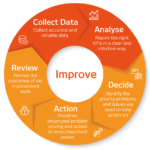KPI Management – Using KPIs to improve your business
KPIs are the first step for improving or controlling a business. Measures are the eyes and ears of anyone who has to manage anything bigger than a one-man business. KPI management is all about using KPIs to give you a clear and honest view of whichever organisation you are looking at.
I use two processes to help with this. I’ve turned both into checklists to help you make sure you have everything covered.
The first process is to create the measures. The second is to manage or improve on a continuous basis, called an “improvement cycle”. Let’s have a look at the “improvement cycle” control process.
1. Capture and analyse process data.
Do we have a clear definition of each and every measure we are using? For help on the KPI bit of KPI management here’s a full definition checklist to help you nail this down.
The short version is:
Make sure the definition is unique. It’s not uncommon to have multiple versions of very similar sounding measures. Either harmonise all the similar-sounding measures into one definition or give them distinctive names (or numbers) and rigorously maintain precise definitions of each.
Be clear on the calculation(s) involved. There can often be several steps involved in producing a final figure. Document every calculation from source to output.
Document the exact source of the data. Document data sources, right down to tab, spreadsheet name and server path for all relevant source data.
Keep a KPI database. It doesn’t have to be complicate (a spreadsheet will often do), but make sure you keep one definitive record.
2. Present the data and decide on action.
Understanding how the user interprets and digests information is absolutely crucial. There’s lots of help and guidance on precisely how to build dashboard and reports that are really effective in my book, BlinkReporting. You can download the free sample that gives lots of hints and tips. If you like that then you can buy my book here or on buy BlinkReporting as a PDF download here.
3. Deliver action/improvement.
This is the management bit of KPI management. To be effective a meeting (the usual place where data is discussed and decisions are made) must have a really clear set of objectives, inputs and outputs. The way to do this is a meeting “terms of reference”. Things you need in place include:
Who attends and who chairs the meeting. It’s best to specify by role and name, not just name, so that when people move on or change role then it’s clearer who should stand in for them.
Medium. Is it a face to face meeting, telepresence or teleconference? Location may need to be specified.
Duration. How long should the meeting run for? It’s important to be realistic here and understand why a meeting regularly takes longer than is scheduled, if that’s an issue.
Frequency. How often does the meeting happen?
Meeting inputs and responsibility for those inputs. What needs to be available before (or at the start of) the meeting to make it successful? Typically this will include reports, dashboards or commentary. Putting a “responsible” name to each of those inputs makes sure that someone is “on the hook” for making sure the input is ready on time and correct.
Agenda. What is the topic(s) for discussion in the meeting? It is worth being clear on what isn’t on the agenda, particularly if the meeting often gets sidetracked.
Meeting outputs and responsibility for those outputs. This will normally take the form of documented actions. Make sure these have a “who”, “what”, “when” and “what” associated with them.
4. Review the impact of action.
Action is only worthwhile if it delivers positive lasting change. If you have an effective dashboard/reporting system in place and an appropriate meeting (with the right participants) then the final step is to follow up previous agreed actions and to see if they have really delivered. This step fits in as part of steps 1, 2 and 3 but needs to be consciously addressed, usually as an agenda item on the meeting “terms of reference”.
The key thing to remember is that KPI management is the complete cycle that delivers benefit and the cycle is only as strong as its weakest link. You need to work hard to make sure each link is strong so that you can deliver an effective improvement cycle. It’s not good having brilliant analytics if your decision-making process is broken or you organisation is incapable of delivering effective action.
If you need help doing this, or just have some comments or feedback, don’t forget to get in touch with Bernie or leave a comment below.






